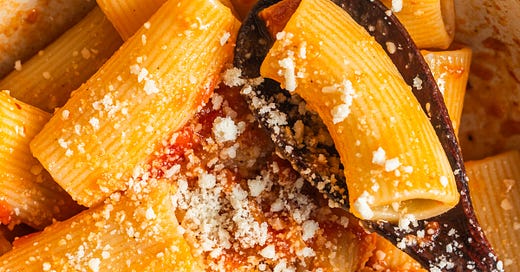Hi friends,
I'll let you in on a secret: I love all the Roman pastas equally. They are like my children - how could I ever choose?
Cacio e pepe was the first of the four I tried, with its salty, spicy, and creamy pecorino and black pepper emulsion. Then there was carbonara, the most luxurious (in my opinion)! And gricia, a lesser-known option in the US, found my heart in Italy.
Over the coming months, I’ll be sharing my take on all four dishes, but I wanted to start with amatriciana. There's something about the coziness of the tomato sauce, the crispy guanciale, and the slight funk of the pecorino that feels just right in the depths of winter.
The Origins
The exact origins of the dish are contested, but it likely began in the town of Amatrice, Italy. There, 'amatriciana bianco' (familiarly known as pasta alla gricia) or pasta with pecorino, black pepper, and guanciale, was common.
Rachel Roddy's column notes, "Amatriciana is [sic] dish invented by shepherds, who would go high into the mountains during the transhumance with their flocks in the valley of Amatrice. They had pecorino cheese in abundance; they would also carry guanciale (cured pork jowl), dried pasta, wine and a curl of the red chilli you so often see hanging in great bunches above doorways in Abruzzo."
Eventually, the introduction of tomatoes brought in a new take on the dish; that rendition then traveled to Rome, where it took on a slightly different form.
Today, in Amatrice, you can find both versions, usually paired with spaghetti. Often, a splash of white wine is added to the crisped-up meat, likely to balance the richness of the guanciale and deglaze the pan. In the warmer months, fresh tomatoes may be used.
The Roman Version
In Rome, you’ll often find bucatini or rigatoni used instead of spaghetti, especially in Northern Lazio. Another distinction is the use of onions—rarely seen in Amatrice, but a common addition in Rome.
Regional Similarities
Regardless of the origin, all my research stressed the importance of the rose-colored sauce.
Roddy writes, "The pasta shouldn’t be drowned in red, but covered in a thin mantle of sauce studded with pork, enriched with sharp, tangy pecorino."
Chef Evan Funke of Felix Trattoria in Los Angeles goes so far as to say that the sauce should be a 50/50 ratio of fat to tomato sauce.
It's that combination, the little bit of tomato sauce, the rendered fat, and the pecorino, when whisked together, that forms an almost creamy, slightly orange coating for the pasta.
Recipe Testing
I tested both regional variations and realized so much comes down to preference. The pared-down version from Amatrice was truly unctuous, with fatty, crispy-gone-soggy notes of guanciale between pops of acidity from the tomato.
In the Roman test, I added some chopped red onion. We ended up preferring this ever-so-slightly, as we found the sweetness of the onion helped balance the other flavors.
My version, adapted from Evan Funke's recipe, includes guanciale + red onion + red chili flakes + a splash of white wine + chopped tomatoes + cheese. It's a bit of an amalgam between the two, so it's not completely traditional, but it's very close.
I suggest you try and adjust this version to suit your tastes. Don't like the onion? Omit it! Want more tomatoes? Do it. Make this your own!
Guanciale
Guanciale is an unsmoked, cured pork product made from the jowl or cheek of the pig. It has a rich, salty, savory flavor with a high-fat content. It's often cured with spices like salt, black pepper, and various herbs.
It can be difficult to find in the US, but I've had success at specialty cheese stores, butcher shops, Eataly and Amazon.
Substitutions
If you're struggling, I recommend seeking a good quality pancetta or thick-cut bacon, at least ¼-inch thick.
Bacon is smoked, unlike pancetta and guanciale, so it will take on a somewhat unique flavor. However, I do believe a good-quality thick-cut bacon will be better than a low-quality piece of guanciale -- so go for the best meat you can!
Similar to guanciale, pancetta is unsmoked, but it's a bit milder and less fatty. If using pancetta, use 4 ounces instead of 3 and add a bit of olive oil into the pan to account for the difference in fat.
Grab the full recipe below ↓
Have a great week,
Karishma @ the Home Cooking Collective





